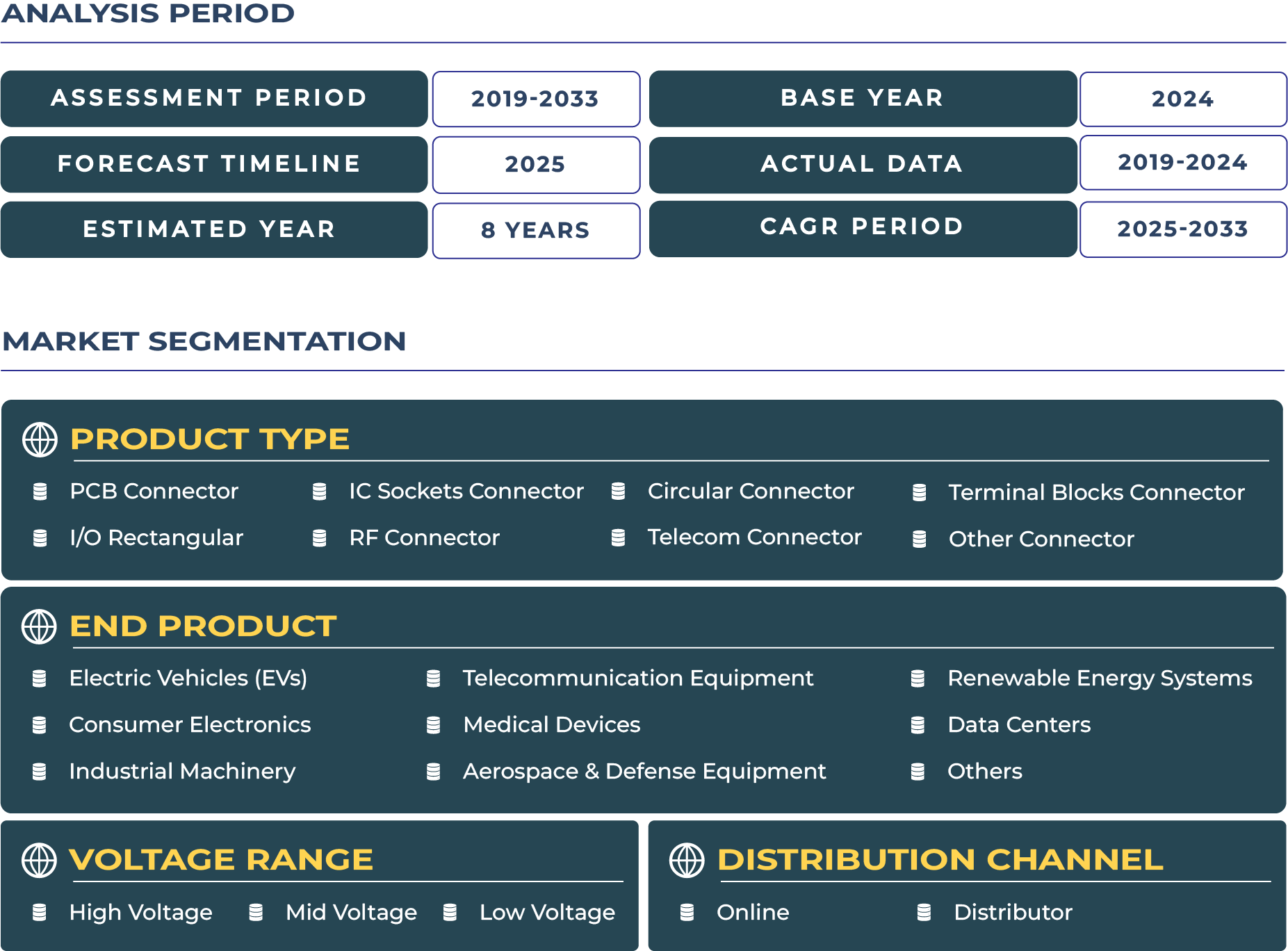Report Format:
![]()
![]() |
Pages: 110+
|
Pages: 110+
Indonesia Connector Market Outlook
Indonesia connector market is accelerating into a growth phase that few regional supply chains can match, and—as per David Gomes, Manager – Semiconductor —is now forecast to climb to just over USD 2.57 billion by 2033, averaging about seven percent compound annual growth in that window. The immediate catalyst is the country’s push to localise the electric-vehicle value chain: a USD 1.1 billion Hyundai-LG Energy Solution battery park in Karawang will ramp from 10 GWh today to 30 GWh by 2027, requiring flame-retardant, high-current board-to-battery connectors that tolerate 45 °C ambient temperatures and daily fast-charge cycles. Executive engineers at PT Hyundai Motor Manufacturing Indonesia confirm that upgrading to copper-alloy terminals with nano-coatings has trimmed thermal loss by nearly 12 % in pilot lines, while local tier-1 supplier Astra Otoparts expects EV-specific connector revenue to double in the next two years as Jakarta’s zero-emission bus programme orders 1,000 high-voltage harness sets.
Data-centre proliferation is the second structural driver. DCI Indonesia’s new 36 MW JK6 module, the largest single-building facility in the archipelago, integrates more than 500 km of MPO fiber connectors for 400 GbE links and uses blind-mate power connectors rated for 48 Vdc busbars to shave energy use per compute load by eight percent. Microsoft’s commitment to inject USD 2.5 billion into Jakarta cloud zones through 2028 brings another layer of demand for low-loss, high-density interconnects, especially as Indonesian data-usage per capita (sub-1 W) catches up with Asian peers now consuming up to 90 W. Suppliers such as TE Connectivity and Amphenol are therefore partnering with domestic cable-assembly houses to pre-terminate fiber trunks locally, accelerating lead times for hyperscale customers.
Grid modernisation and renewable-energy build-outs amplify the need for durable connector systems. The 69.5 GW capacity addition outlined in PLN’s 2025-2034 RUPTL devotes 17 GW to solar and 11 GW to hydropower, demanding IP68-rated PV string connectors and corrosion-resistant bus-duct joints for floating solar arrays on Cirata reservoir. Government planners estimate that super-grid interconnections such as the 1,680 km Sumatra–Java HVDC link will require more than 1.6 million crimp-type compression lugs and composite suspension clamps—products that niche Indonesian firms like PT Supreme Cable Manufacturing are already tooling with recycled aluminium alloys to meet local-content mandates.
Telecommunications complete the growth quartet. With monthly mobile-data consumption poised to soar from 11.7 GB in 2023 to 25.5 GB by 2028, XL Axiata’s proposed merger with Smartfren is expected to unlock a USD 600 million 5G capex burst, including massive-MIMO radio heads that rely on multi-coax quick-lock connectors rated for 6 GHz Wi-Fi 7 backhaul. Telkomsel’s edge-data-centre strategy likewise increases demand for compact mezzanine connectors enabling 400 TOPS AI inference cards in base-station shelters.
Industry sentiment underscores confidence. “Connector reliability is now a board-level KPI because downtime penalties on hyperscale SLAs can wipe out margins,” notes Rizki Fadli, director of Bandung-based OEM Citra Interconnect. Meanwhile, Budi Mulya, CTO at state utility PLN, argues that “Indigenous connector production will be critical for supply security once 76 percent of new power comes from variable renewables.” These executive insights mirror rising investor interest: three Indonesian connector start-ups secured a combined USD 40 million in Series A rounds last year to develop bio-based polymer housings and fibre-optic ferrules from volcanic-ash ceramics.
The growth trajectory is not without risks. Persistent nickel-price volatility following a 45 % crash in 2023 could slow EV-battery output and, by extension, high-current connector volumes. Battery-chemistry shifts toward nickel-free LFP cells may dilute Indonesia’s raw-material advantage, while power-quality fluctuations on Java’s grid remain a threat to data-centre uptime. Nonetheless, government VAT incentives for EVs with 40 % local content, the launch of Wi-Fi 7 spectrum allocations, and a planned USD 34 billion super-grid budget all combine to fortify medium-term demand. For connector manufacturers, the strategic imperatives are clear: invest in heat-resistant alloys, embed ESG-traceable supply chains, and pursue co-development agreements with fast-scaling OEMs.
Authors: David Gomes (Manager – Semiconductor)
*Research Methodology: This report is based on DataCube’s proprietary 3-stage forecasting model, combining primary research, secondary data triangulation, and expert validation. [Learn more]







